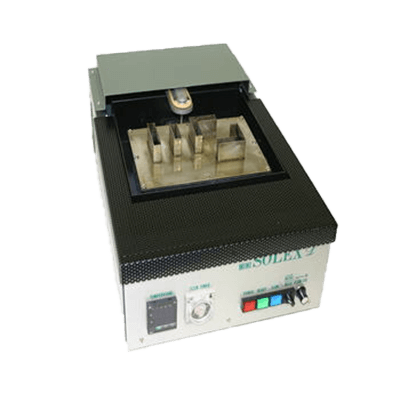What Is a Solder Pot?
 A solder pot is a container that holds or is filled with molten solder and equipped with a heater to keep the solder in a molten state.
A solder pot is a container that holds or is filled with molten solder and equipped with a heater to keep the solder in a molten state.
Depending on the shape and quantity of the object to be soldered, solder pots range in size from tabletop units for use in laboratories to large units for use on production lines.
There are two types of solder pots: stationary units, in which the solder remains stationary inside the pot, and jet-flow solder pots, in which there is a nozzle inside the pot and the solder flows out in jets.
Uses of Solder Pot
Solder pots are well suited for tasks such as soldering leads and mounting components on printed circuit boards. While soldering may be done manually, solder pots are useful for efficiently soldering large volumes of simple, stable objects and achieving consistent results.
Principle of Solder Pots
Solder pots consist of a container for storing molten solder and a heater for keeping the solder in a molten state. Their basic structure is simple, but most solder pots used in production environments are equipped with a conveyor that can precisely control the temperature of the solder pot and transport objects into it.
The molten solder in a solder pot oxidizes when exposed to air for a long period of time. Oxides deteriorate the wettability between the solder and the base metal to be soldered, which is a major cause of solder defects.
It is important to always supply molten solder that is not oxidized to achieve good results. This is why jet-flow solder pots, in which a nozzle spurts molten, unoxidized solder from inside the solder pot into contact with the base metal, are often preferred.
Although measures to remove oxides are necessary with both stationary and jet-flow solder pots, oxides are less likely to form when using the latter because the solder is always flowing, reducing the amount of work required to remove oxides.
1. Soldering Using a Stationary Solder Pot
Molten solder is placed in the solder pot, and the component to be soldered is immersed in the molten solder. Soldering is completed when the component is pulled out.
2. Soldering Using a Jet-Flow Solder Pot
Jet-flow solder pots are equipped with a nozzle that is used to spray molten solder onto the component.
This method has become widespread in the field of printed circuit board manufacturing. An example of a common automated process is when a chip is built into a printed circuit board, and transported to the solder pot by a conveyor, where jets of molten solder mount it in place.
Other Information on Solder
1. Types of Solder
When using solder, a flux is used to ensure a clean soldering process.
Flux is a liquid containing ammonium chloride or zinc chloride. It is used to remove impurities from the printed circuit board and clean the surface of the board so that it can be soldered cleanly. It is also used to prevent oxidation of the copper wiring on the board surface.
Rosin is a component of pine tar that acts as a flux. It is often incorporated into solder called rosin core solder.
2. Solder Material
Solder is an alloy consisting mainly of lead and tin. Solder is mainly used to make metal bonds between various electronic components and connectors mounted on printed circuit boards, which constitute electronic circuits, and the wiring on the printed circuit boards to enable the conductivity of the components and connectors. Another common application is to facilitate metal bonding between pipes.
The history of solder dates back to around 3000 BC in Mesopotamia. Silver-copper or tin-silver solder was used to attach silver handles to copper vessels. Later, during the Greek and Roman periods, tin-lead solder, which is now the mainstream solder, was used for joining water pipes.
Later, the toxicity of lead became apparent, and the EU became the first country in the world to regulate the use of tin-lead solder via the Rohs Directive of 2006. Today, solder and electronics manufacturers around the world are taking the lead in developing lead-free solders, which are now widely used. Currently, the main solder alloys are tin-silver-copper, tin-copper-nickel, and tin-zinc-aluminum, none of which contain lead.
3. Solder Temperature
The temperature of solder varies depending on the solution, but the melting point of lead-containing solder is 183 °C and that of lead-free solder is around 210 °C. Lead-free solder has a higher melting point, making it more difficult to melt and spread.
However, products comparable to the conventional tin-lead type have now been developed, and the melting points of tin-silver-copper (Sn 96.5%, Ag 3%, Cu 0.5%) and tin-copper-nickel (Sn 99%, Cu 0.7%, Ni and other additives) alloys, which are some of the most common lead-free solders, are 217-227 °C.